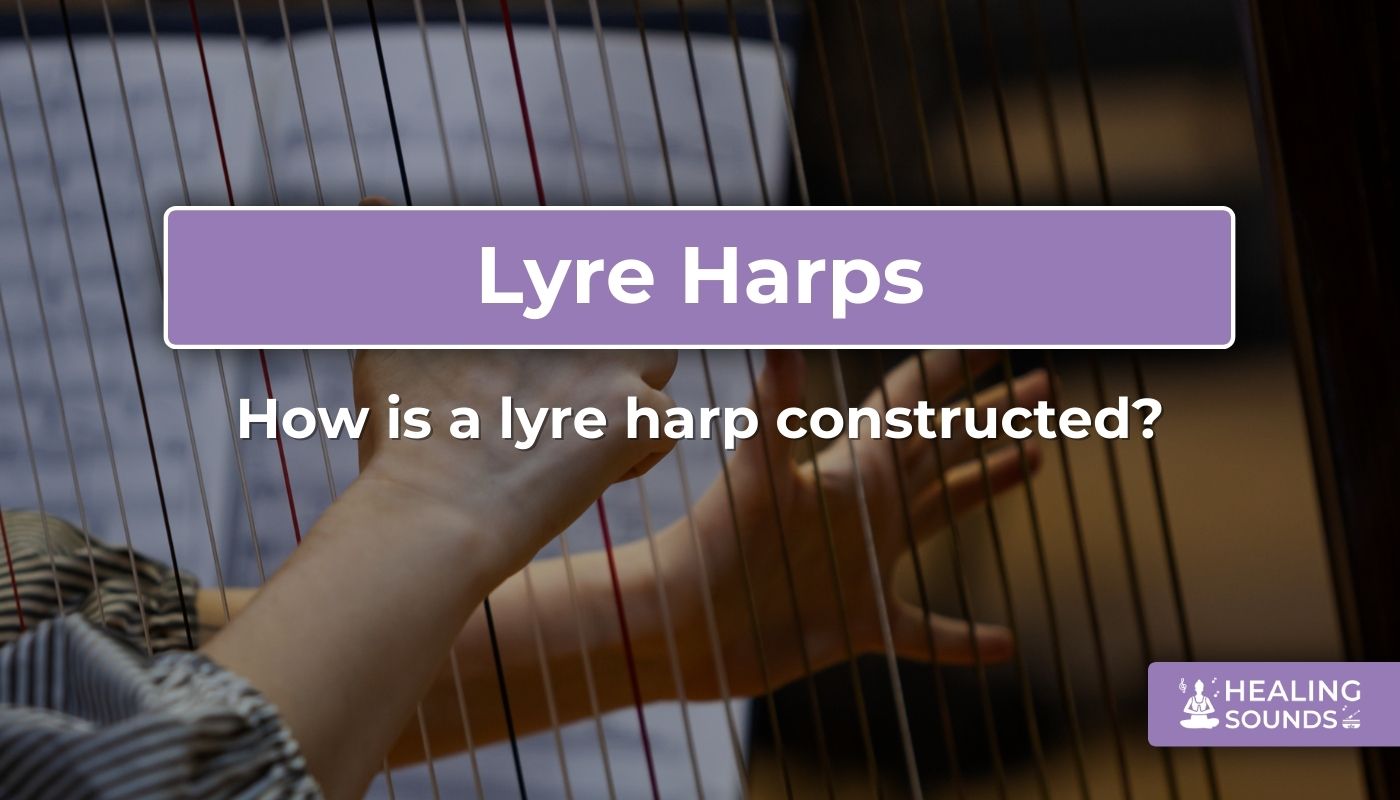The lyre harp, an instrument echoing through millennia, fascinates with its ethereal sound and elegant form. But what goes into creating this captivating instrument? Understanding lyre harp construction reveals a beautiful blend of artistry, acoustics, and meticulous craftsmanship. For musicians and enthusiasts drawn to its unique voice, exploring how a lyre harp is built illuminates the source of its enchanting music and helps in appreciating its quality.
The Anatomy of a Lyre Harp: Understanding the Core Components
Before diving into the building process, let's look at the essential parts that define the structure of the lyre harp. Each piece plays a vital role in the instrument's sound, stability, and overall character.
The Body and Frame: Foundation of Sound
The main body, often including a resonant chamber or soundbox, and the arms extending upwards form the frame. This structure must be sturdy enough to withstand string tension while allowing the instrument to vibrate freely. Lyre harp materials for the body are crucial; hardwoods like maple, rosewood, or mahogany are frequently chosen for their durability and tonal properties. The choice of wood significantly influences the warmth and sustain of the notes produced.
The Resonant Heart: The Soundboard
Often considered the soul of the instrument, the lyre soundboard (or sound table) is a thin piece of wood, typically spruce or cedar, that sits beneath the strings. Its primary function is to amplify the vibrations transferred from the strings via the bridge. The quality, thickness, and bracing of the soundboard are critical factors in the lyre's volume, projection, and tonal colour. Proper lyre soundboard construction is key to a vibrant sound.
Giving Voice: Strings and Tuning Mechanisms
Lyre harp strings are responsible for producing the actual musical tones. Historically made from gut, modern lyres often use nylon, carbon fiber, or metal strings. Metal strings, like those on some modern lyres, tend to offer a brighter, louder sound, while nylon or gut provides a warmer, softer tone. The strings are attached to tuning pins or levers, allowing the player to adjust the pitch precisely. The quality and type of strings directly impact the playing feel and sonic output.
Crafting the Instrument: The Art of Lyre Harp Construction
Building a lyre harp is a process that marries traditional techniques with acoustic principles. While enthusiasts might explore how to build a lyre harp through kits or workshops, professional construction involves deep knowledge and skill.
Material Selection: More Than Just Wood
The first step is selecting the right lyre harp materials. Beyond the primary wood for the body and soundboard, choices include materials for the bridge (transferring string vibration), tuning pins (metal, ensuring stable tuning), and finishes (protecting the wood and potentially influencing damping). High-quality tonewoods, often aged and carefully dried, are preferred. You can explore properties of woods like Spruce or Maple used in instrument making on resources like The Wood Database.
The Assembly Process: Bringing the Lyre to Life
Lyre construction techniques vary, but generally involve:
- Shaping the frame and arms, ensuring precise angles and joins for structural integrity.
- Crafting and bracing the soundboard before carefully fitting it into the body.
- Installing the bridge and drilling holes for tuning pins or mechanisms.
- Applying finishes like oils or varnishes to protect the instrument and enhance its appearance.
- Finally, stringing the lyre and performing initial tuning adjustments.
Each step requires precision to ensure the final instrument is both beautiful and musically sound.
The Finishing Touches: Ensuring Quality and Resonance
After assembly, meticulous adjustments are made. This includes ensuring the bridge placement is optimal for tone transfer and checking that all components are secure. The final setup involves fine-tuning the strings and potentially adjusting nut or bridge heights for comfortable playability. This attention to detail distinguishes a well-crafted lyre harp.

23-String Lyre Harp Instrument with Levers
479.90 623.90
Showcasing expert craftsmanship, this lever harp combines traditional lyre harp construction with modern features for enhanced musical versatility.
Explore This Lever HarpHow Lyre Harp Construction Impacts Sound and Playability
Understanding how a lyre harp works fundamentally ties back to its construction. The way a lyre is built directly influences its sonic characteristics and how easy or enjoyable it is to play.
Sound Quality & Resonance
The choice of wood, the design of the soundbox, the quality of the soundboard, and even the type of finish contribute to the lyre's overall tone. A well-constructed lyre will have clear tones, good sustain, and balanced resonance across its range. Poor construction might result in a muted sound, buzzing strings, or structural instability.
Durability & Longevity
Solid joinery, appropriate wood thickness, and proper tension management ensure the lyre harp can withstand the constant pull of its strings over many years. Quality lyre harp construction means the instrument will remain stable and playable for longer.
Ease of Play
While lyres are generally considered accessible instruments, aspects like string spacing, the smoothness of tuning mechanisms, and the overall ergonomics are influenced by construction. For beginners asking "Is the lyre harp easy to learn?", a well-made instrument with comfortable features can certainly make the initial learning process smoother.
- Materials: Define the core tonal character (warmth, brightness).
- Soundboard: Governs volume, projection, and responsiveness.
- Frame Integrity: Ensures stability and longevity under string tension.
- Setup: Affects playability, tuning ease, and clarity.
Discover Our Handpicked Lyre Harps

17 String Rosewood Lyre Harp Instrument by Hluru
59.90
79.90
Crafted from Rosewood, showcasing how specific lyre harp materials contribute to unique sound experiences for relaxation. Learn more ➔

24 String Lyre Harp Instrument with Steel Strings
89.90
116.90
Features steel lyre harp strings for superior clarity and resonance, a key aspect of its specific lyre harp construction. Learn more ➔

16-String Lyre Harp Instrument for Beginners
69.90
90.90
A great entry point, its simpler lyre harp construction makes it accessible and ideal for beginners exploring the instrument. Learn more ➔
Beyond the Workshop: The Lyre Harp's Role
The enduring appeal of the lyre harp isn't just due to its construction but also its rich history and applications.
Historical Significance
From ancient Greece to Celtic traditions, the lyre family holds deep cultural roots. Its construction methods have evolved, but its presence in mythology, art, and music remains significant.
Therapeutic Applications
As Healing Sounds champions, the gentle, resonant tones of the lyre harp are well-suited for sound healing and therapy. Its soothing frequencies can aid relaxation, reduce stress, and promote mindfulness. The intentional construction contributes to sounds that foster well-being.
Conclusion
Exploring lyre harp construction reveals the fascinating intersection of natural materials, skilled craftsmanship, and acoustic science. From the careful selection of woods like spruce and maple to the precise assembly of the frame, soundboard, and strings, each element is crucial in creating an instrument capable of producing captivating and often healing sounds. Understanding how these instruments are made not only deepens appreciation for their music but also helps in choosing a quality lyre harp suited to your needs.
Whether you are a musician, a sound therapy practitioner, or simply drawn to its beauty, appreciating the construction behind the lyre harp enhances the connection to its timeless melodies. Explore the collection at Healing Sounds to find a lyre harp crafted with care and acoustic integrity.
Frequently Asked Questions about Lyre Harp Construction
The basic structure of a lyre harp consists of a body (often with a soundbox), two arms extending upwards from the body, and a crossbar (or yoke) connecting the arms. Strings run from a bridge or tailpiece on the body/soundboard up to tuning pins located on the crossbar.
Historically and generally, lyre harp construction involves shaping wood for the body, arms, and crossbar. A soundboard (often thinner wood) is attached to amplify string vibrations. Holes are drilled for tuning pegs/pins. Strings (historically gut, now often nylon or metal) are attached and tensioned across a bridge.
A lyre harp works by plucking its strings, causing them to vibrate at specific frequencies (notes). These vibrations are transferred through the bridge to the soundboard. The soundboard, due to its construction and larger surface area, amplifies these vibrations, projecting the sound outwards for the listener to hear.
Yes, the lyre harp is generally considered one of the easier string instruments to begin learning, especially compared to instruments requiring complex bowing or fretting. Its simple structure and diatonic tuning (often) make basic melodies accessible quickly. The quality of the lyre harp construction can also impact ease of tuning and playability.
Common lyre harp materials include hardwoods like maple, mahogany, rosewood, or cherry for the body and frame due to their strength and tonal qualities. Softwoods like spruce or cedar are often used for the soundboard because of their excellent resonance. Strings can be nylon, gut, carbon fiber, or metal (steel, bronze).

